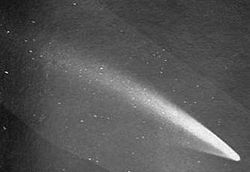Great January comet of 1910

C/1910 A1, the Daylight or Great January Comet, photograph from Lowell Observatory
|
|
| Discovery | |
|---|---|
| Discovered by | Multiple observers |
| Discovery date | January 12, 1910 |
| Alternative designations |
1910 I 1910a |
| Orbital characteristics A | |
| Epoch | January 9, 1910 (JD 2418680.5) |
| Aphelion | ~2974 AU |
| Perihelion | 0.128975 AU |
| Semi-major axis | ~1487 AU |
| Eccentricity | 0.999995 |
| Orbital period | ~57,300 yr |
| Inclination | 138.7812° |
| Last perihelion | January 17, 1910 |
| Next perihelion | unknown |
The Great January Comet of 1910, formally designated C/1910 A1 and often referred to as the Daylight Comet, was a comet which appeared in January 1910. It was already visible to the naked eye when it was first noticed, and many people independently "discovered" the comet. At its brightest, it outshone the planet Venus, and was possibly the brightest comet of the 20th century.
The comet brightened rather suddenly, and was initially visible from the southern hemisphere only. A number of individuals claimed "discovery", but the comet is thought to have been first spotted by diamond miners in the Transvaal before dawn on January 12, 1910, by which time it was already a prominent naked-eye object of apparent magnitude −1.
The first person to study the comet properly was Scottish astronomer Robert T. A. Innes at the Transvaal Observatory in Johannesburg on January 17, after having been alerted two days earlier by the editor of a Johannesburg newspaper.
The comet reached perihelion on January 17 and was at that time visible in daylight with the unaided eye; following perihelion, it declined in brightness but became a spectacular sight from the northern hemisphere in the evening twilight, its noticeably curved tail reaching up to 50 degrees by early February.
The year 1910 saw considerable media interest in the predicted return of Halley's Comet, which reached perihelion on April 20. The appearance of the Daylight Comet several months earlier therefore came as something of a surprise, and made an extremely strong impression on an expectant public; when Halley's Comet returned again in 1986, many older people's accounts of having seen it in 1910 clearly referred to the Daylight Comet instead.
Owing to a "telephonic error", the comet was initially reported as being named Drake's Comet, though once the error was realised the press afterwards referred to it as the Daylight Comet or Sunset Comet, as no single individual was credited with its discovery.
...
Wikipedia
